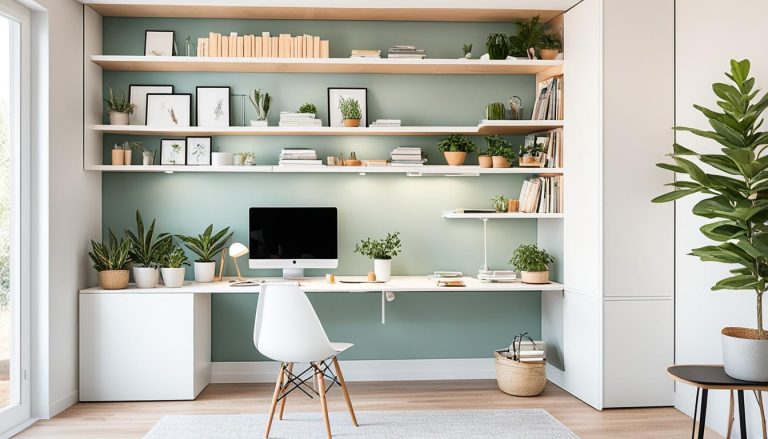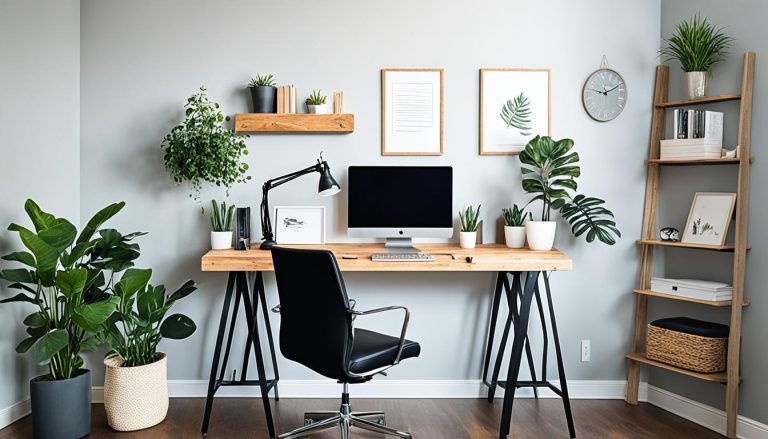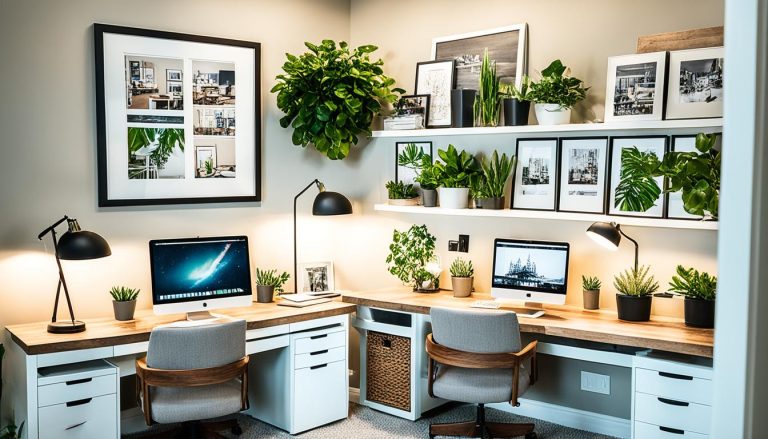Ergonomic Home Office Designs for Health and Comfort
houseremodelingnews.com may earn a commission if you purchase a product through one of our links
“The secret of change is to focus all of your energy, not on fighting the old, but on building the new.” – Socrates
Remote work is now common, making your home office key. Ergonomic designs are essential for your health and work efficiency. With many working from home, it’s vital to have a workspace that supports your well-being and boosts your productivity.
Home office ergonomics is more than just a comfy chair. It’s about making an environment that reduces body strain and increases your work output. Details like the right desk height and proper lighting are important for a space that supports your health and career growth.
This guide will show you how to make an ergonomic home office that looks and feels great. You’ll get tips to increase your office productivity and protect your health. Let’s explore ergonomic home office designs and turn your workspace into a place of comfort and efficiency.
The Importance of Ergonomics in Home Offices
Remote work setups are becoming more popular. It’s key to make your work area ergonomic for your health and work efficiency. Let’s see why ergonomics are important in your home office and how they help your wellness.
Understanding Ergonomics and Its Benefits
Ergonomics is about designing workspaces that match your body and how you work. A good ergonomic home office setup cuts down on physical strain. It also helps with posture and makes you more comfortable.
This means you can focus better and work more efficiently during the day.
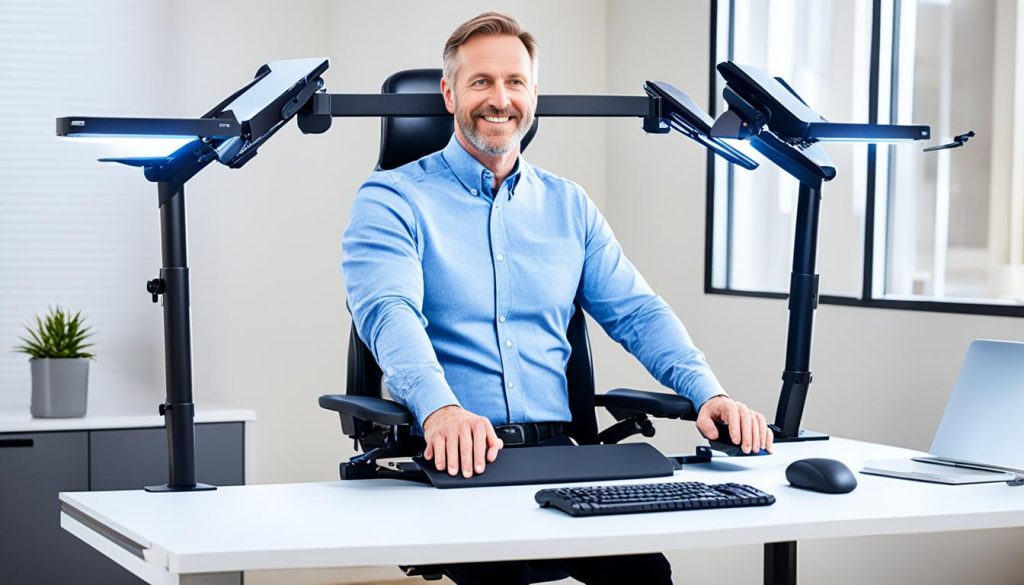
The Impact of Poor Ergonomics on Health and Productivity
Ignoring ergonomics in your home office can harm your health. You might get poor posture, repetitive strain injuries, or eye fatigue. These can lead to long-term pain and make you less productive at work.
By focusing on office wellness, you can dodge these problems. This helps you keep a good balance between work and life.
Long-term Benefits of Ergonomic Home Office Setups
Choosing ergonomic workstations has long-term benefits. You’ll feel less pain, take fewer sick days, and think more clearly. Ergonomics can also stop chronic issues like carpal tunnel syndrome and lower back pain.
Creating a supportive work area sets you up for success in remote work. It’s an investment in your health and career.
“A well-designed ergonomic workspace is an investment in your health and career longevity.”
Small changes in your home office can greatly improve your well-being and productivity. Take time to check and better your workspace ergonomics today.
Essential Elements of an Ergonomic Home Office
Creating an ergonomic home office means picking the right furniture and setting up your space well. Let’s look at the main things you need for a comfy and efficient work area.
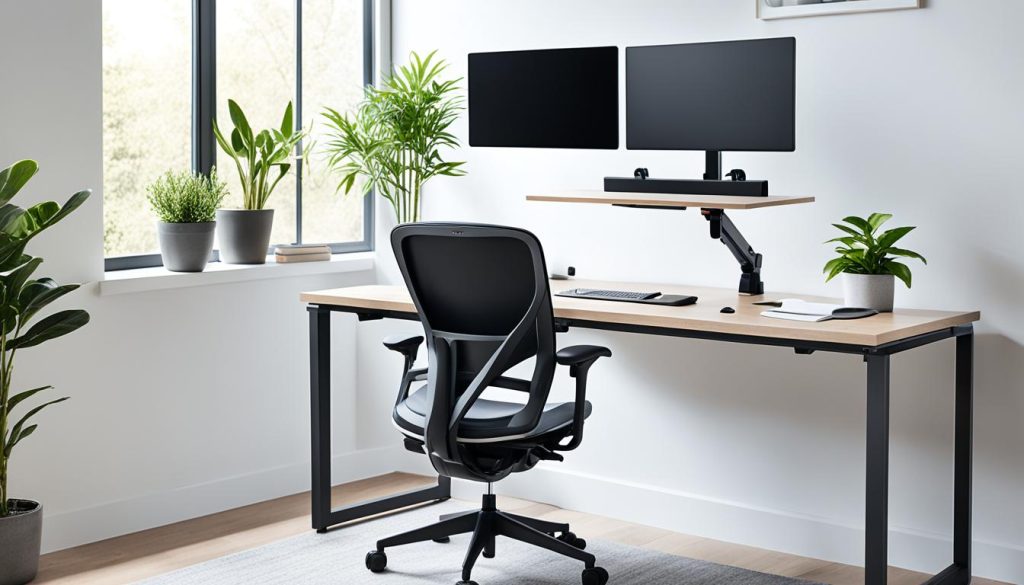
Begin with a desk that’s designed well. It should be adjustable to fit sitting or standing. This helps you keep a good posture and lowers back pain risks.
Then, choose furniture that’s good for your body. A chair with lumbar support, adjustable armrests, and a breathable backrest is key. It helps you stay in the right posture during long hours of work.
- Adjustable monitor stand or arm
- Ergonomic keyboard and mouse
- Footrest for improved leg circulation
- Task lighting to reduce eye strain
Don’t overlook storage solutions. Keeping your workspace tidy helps you work better and think clearer. Think about using vertical storage to save floor space in small offices.
“A well-designed ergonomic workspace is an investment in your health and productivity.”
The aim of ergonomic furniture is to fit your body, not the other way around. Make sure to adjust your setup often and pay attention to what your body tells you. With these key elements, you’ll have a home office that supports your health and helps you work better.
Choosing the Right Ergonomic Chair
Finding the perfect ergonomic chair is key to a comfy workspace. A good chair helps keep your posture right and supports you during long hours at work.
Key Features to Look for in an Ergonomic Chair
When looking for ergonomic chairs, remember these must-haves:
- Adjustable seat height
- Lumbar support
- Breathable material
- Armrest adjustability
- Swivel base
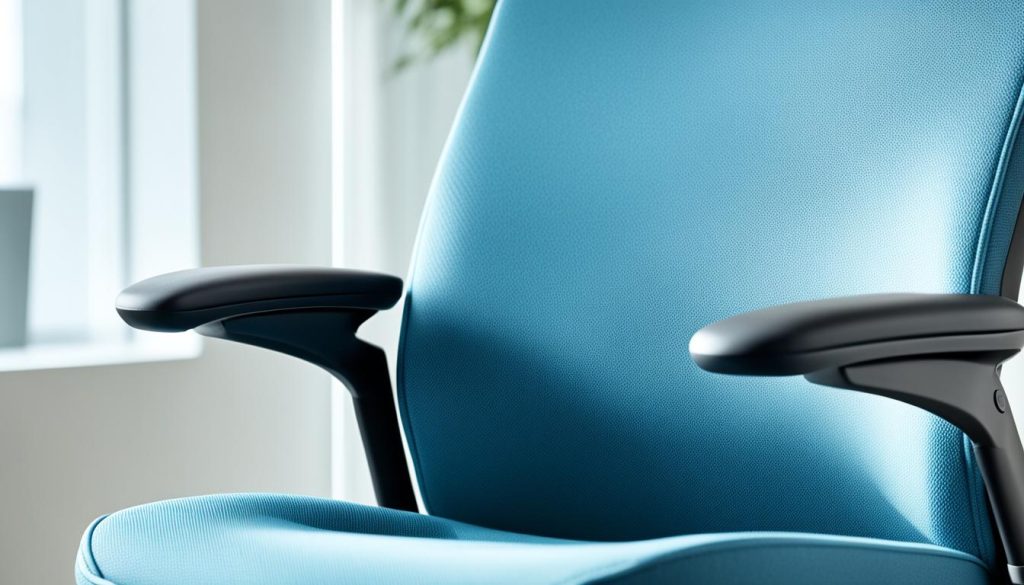
Top Ergonomic Chair Recommendations
Check out these top-rated ergonomic chairs for your home office:
- Herman Miller Aeron
- Steelcase Gesture
- Humanscale Freedom
Proper Chair Adjustment Techniques
To get the most support and comfort, follow these steps:
- Adjust seat height so your feet rest flat on the floor
- Set lumbar support to fit your lower back curve
- Position armrests to support your elbows at a 90-degree angle
The best ergonomic chair is one that suits your body and work needs. Take your time to try out different chairs and adjust them for your perfect workspace.
Optimal Desk Setup for Comfort and Productivity
Creating a productive home office starts with the right desk setup. Your workspace layout affects your efficiency and comfort. Let’s look at how to make your desk work best for you.
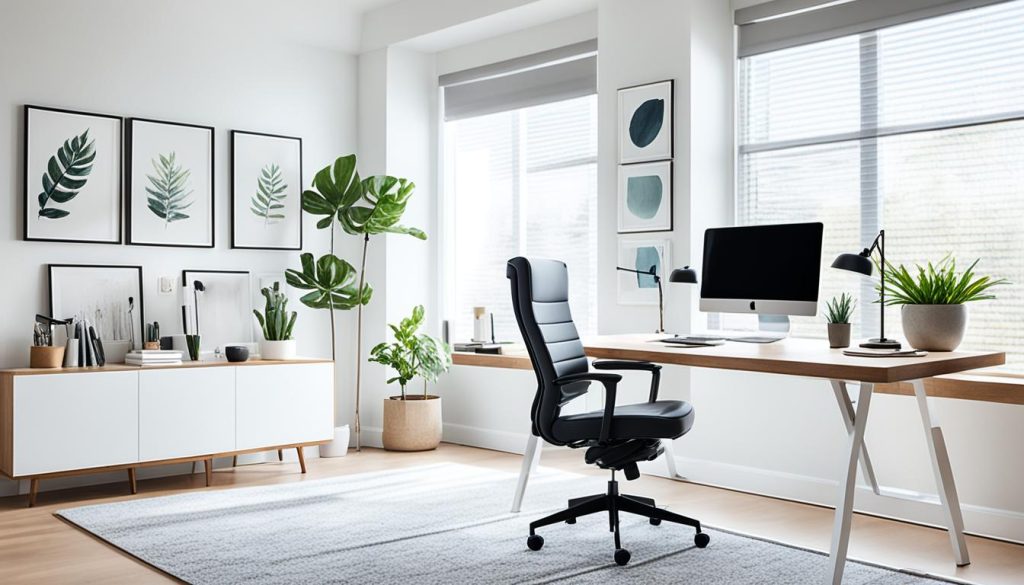
First, think about desk height. A desk that’s too high or low can cause bad posture and discomfort. Try to find a height where your elbows are at a 90-degree angle when typing. This helps with computer workstation ergonomics and reduces strain on your shoulders and neck.
Then, think about where you put your equipment. Put your monitor at arm’s length, with the top of the screen at eye level. This stops neck strain and eye fatigue. Keep your keyboard and mouse close together to avoid reaching.
- Keep things you use often within easy reach
- Use a document holder to reduce neck movement
- Invest in a footrest if your feet don’t touch the ground
Being organized is crucial for a productive home office. Use desk organizers, drawer dividers, and cable management solutions to keep things tidy. A clean workspace helps you stay focused and boosts productivity.
“A well-organized desk is a window to a well-organized mind.”
Your home office layout should fit your needs. Try different setups until you find the best mix of comfort and efficiency. With the right desk setup, you’ll have a workspace that supports your productivity and well-being.
Ergonomic Home Office Designs: Layouts and Configurations
Creating the perfect home office setup is all about planning and thinking about your workspace ergonomics. Let’s look at different layouts and configurations to make your telecommuting setup efficient and comfy.
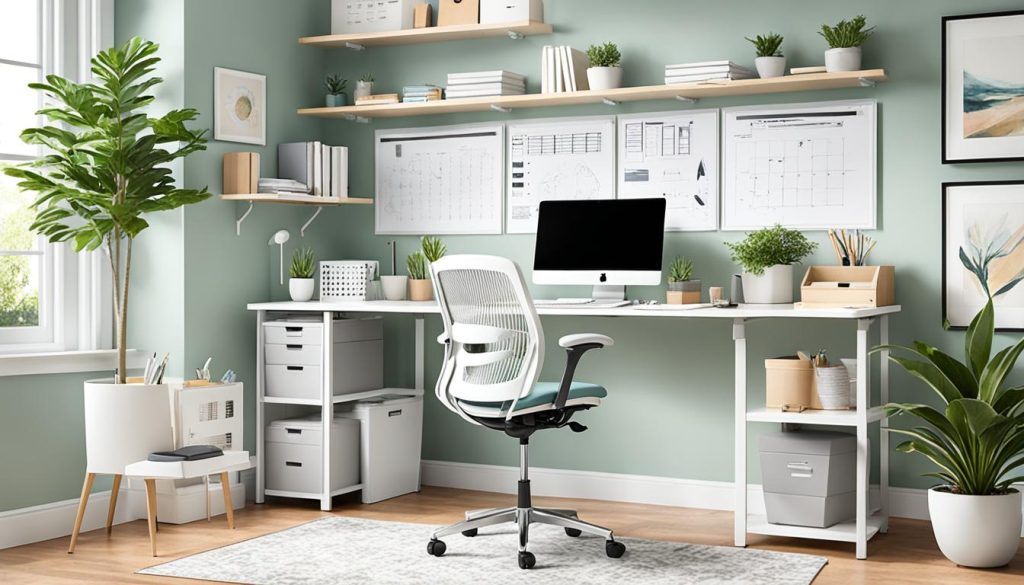
Space-saving Designs for Small Home Offices
If you have limited space, here are some smart ideas:
- Wall-mounted desks that fold away when not in use
- Corner desks to make the most of unused areas
- Floating shelves for storage without taking up floor space
These options help you keep good ergonomics without taking over your living space.
Open-concept Ergonomic Office Layouts
If you have more room, an open-concept layout can improve your productivity and comfort. Try:
- L-shaped desk setups for different work areas
- Putting your desk near a window for natural light
- Creating a mini lounge area for breaks and brainstorming
These layouts encourage movement and flexibility in your workspace.
Multi-functional Ergonomic Workspace Ideas
Make your home office do more with these multi-functional ideas:
- Standing desk converters for switching between sitting and standing
- Modular furniture systems that change for different tasks
- Built-in storage solutions to keep your workspace tidy
By adding these elements, you’ll have a versatile telecommuting solution that supports your health and productivity.
Proper Lighting for Eye Comfort and Productivity
Lighting is very important for a healthy office setup. It helps make the office a comfortable and efficient place. This makes it easier to stay focused and productive all day.
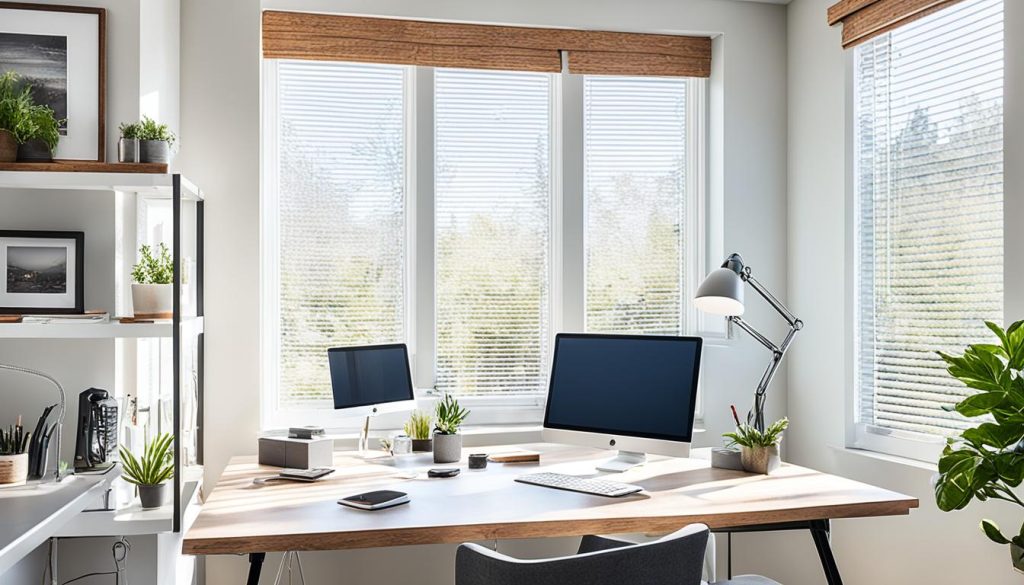
Natural light is the best for boosting productivity. Try to place your desk near a window to get daylight. If that’s not possible, use full-spectrum light bulbs. These bulbs help reduce eye strain and keep your body’s natural rhythm.
Stay away from harsh overhead lighting. Use a mix of ambient and task lighting instead. A desk lamp with adjustable brightness lets you control the light for different tasks and times.
- Use indirect lighting to minimize glare on screens
- Position light sources to the side or behind your line of sight
- Adjust screen brightness to match your surroundings
Good lighting does more than just help you see. It creates a comfortable space that supports your health and work performance. Investing in good lighting means investing in your health and productivity.
“Light is the first element of design; without it there is no color, form, or texture.” – Thomas E. Farin
Ergonomic Keyboards and Mice: Reducing Strain on Wrists and Hands
Creating an ergonomic workstation is key to avoiding injuries. Choosing the right input devices for your computer is important. Ergonomic keyboards and mice can lessen wrist and hand strain.
Benefits of Ergonomic Input Devices
Ergonomic keyboards and mice keep your hands in a natural position. This helps prevent repetitive strain injuries and makes working at a computer more comfy. People often feel less pain and get tired less when using these devices.
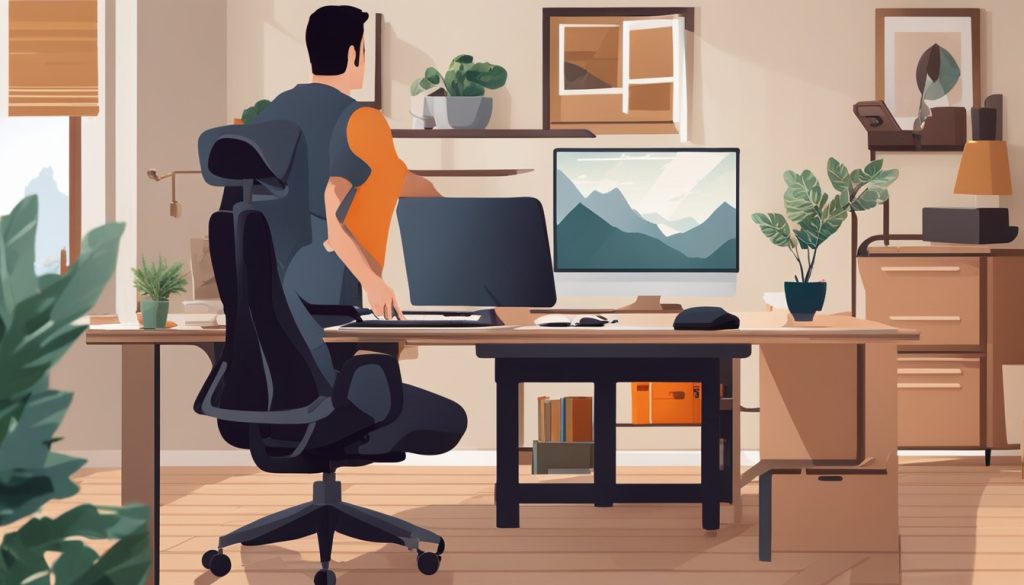
Top-rated Ergonomic Keyboards and Mice
Some top ergonomic keyboards are:
- Microsoft Sculpt Ergonomic Keyboard
- Logitech ERGO K860
- Kinesis Freestyle2
For mice, consider:
- Logitech MX Vertical
- Anker Vertical Ergonomic Mouse
- Evoluent VerticalMouse 4
Proper Positioning and Use of Input Devices
To get the most out of your ergonomic devices:
- Keep your keyboard at elbow height
- Position your mouse close to the keyboard
- Maintain a neutral wrist position
- Take frequent breaks to stretch
Even the best ergonomic devices need proper use to prevent injuries at computer workstations.
Monitor Positioning and Multiple Screen Setups
Getting your monitor in the right spot is key for a comfy and productive workspace. The way you set up your screen can greatly affect your health and work efficiency. Let’s look at how to arrange your monitors for better health and work.
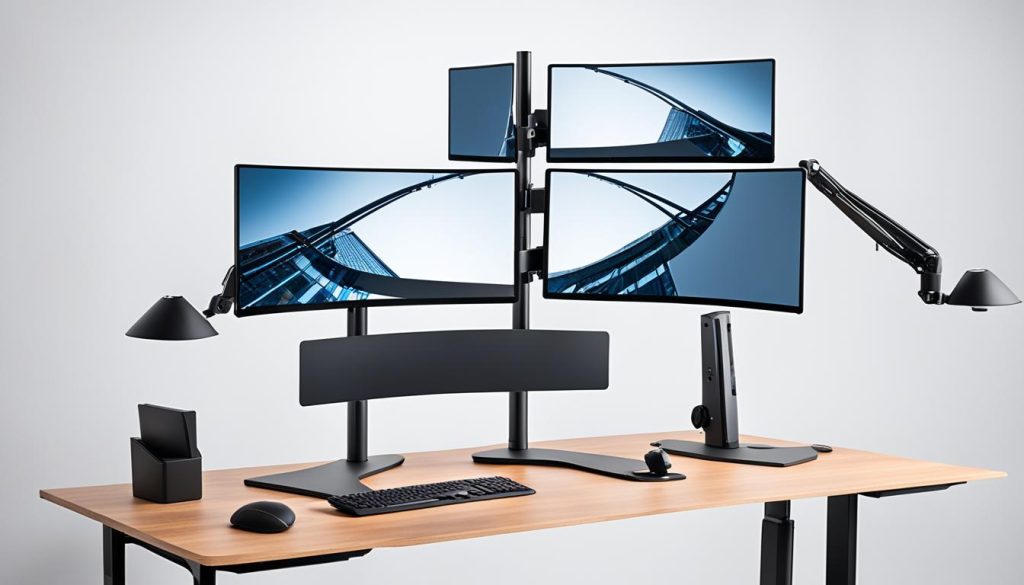
Put your main monitor right in front of you. Make sure the top of the screen is at or just below your eye level. This setup helps prevent neck pain and keeps your posture right. Aim for a distance from your eyes to the screen that feels like an arm’s length.
Here are some tips for using multiple screens at work:
- Position your primary screen directly in front of you
- Place secondary screens to the sides at the same height and distance
- Angle secondary screens slightly inward to create a gentle curve
Having multiple screens can really boost your productivity. It lets you spread out your work, compare documents side-by-side, and switch windows less often.
Ergonomic monitor setups can increase productivity by up to 20% and reduce eye strain by 32%.
Don’t forget to take breaks and follow the 20-20-20 rule. Every 20 minutes, look at something 20 feet away for 20 seconds. This simple habit can help reduce eye strain and make long work sessions more comfortable.
Standing Desks and Active Workstations: Pros and Cons
Standing desks and active workstations are now common in home offices. They help with posture and have benefits and challenges for remote work.
Benefits of Standing Desks
Standing desks can make your posture better and lessen back pain. They might also increase energy and productivity. Many people feel more awake and focused at standing desks.

Incorporating Movement into Your Workday
Active workstations promote moving more during the day. Here are some ideas:
- Use a treadmill desk for light walking while working
- Switch between sitting and standing every hour
- Take short stretching breaks
Regular movement cuts down the risks of sitting too much.
Transitioning to a Standing or Active Workstation
Start slow with a standing desk. Begin with 30-minute standing periods and increase them over time. Get a good anti-fatigue mat to ease foot and leg pain. Think about a desk converter to turn your current desk into a standing one.
“I feel more energized and productive since switching to a standing desk in my home office.”
Standing desks have their perks, but they’re not for all. Pay attention to what your body needs and pick the best setup for your remote work.
Ergonomic Accessories for Enhanced Comfort
Creating a comfy home office is more than just the basics. To make your remote work setup better, think about these key ergonomic accessories. They can greatly improve your comfort and productivity every day.
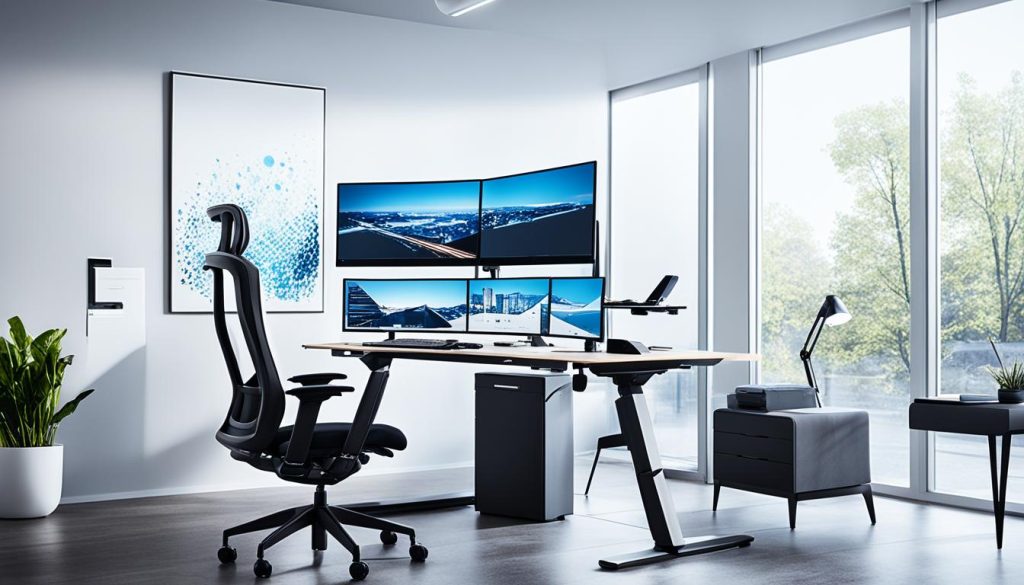
Footrests are crucial for ergonomic furniture. They keep your feet and legs supported, easing strain on your lower back. Choose adjustable ones to match your height perfectly.
Wrist supports are also a must for a comfy office. They offer a soft spot for your wrists when typing or using a mouse. This helps prevent injuries from repetitive stress.
- Document holders: Keep papers at eye level to avoid neck strain
- Monitor stands: Raise your screen for better posture
- Anti-fatigue mats: Ideal for standing desks to lessen foot and leg tiredness
Don’t overlook lighting accessories. A desk lamp with adjustable brightness and color can cut down on eye strain during long work sessions.
“Investing in the right ergonomic accessories can transform your workspace into a haven of comfort and efficiency.”
For a truly comfy home office, tailor your space with the right remote work essentials. With these ergonomic accessories, you’ll have a setup that supports your health and increases your productivity.
Creating a Comfortable and Productive Home Office Environment
Your home office is key to feeling good and staying productive. A well-designed space can make you happier and more efficient. Let’s look at how to make your home office comfy and focused.
Temperature and Air Quality Considerations
Having the right temperature and air quality is crucial for a comfy workspace. Aim for a temperature of 68-72°F (20-22°C) for best focus. An air purifier can clear out allergens and help you breathe easier. Adding plants can also freshen the air and bring in some nature.
Noise Reduction Strategies
Too much noise can mess up your work flow. Here are some ways to reduce it:
- Use noise-canceling headphones
- Install soundproofing materials on walls
- Put a white noise machine in your office
Incorporating Nature and Personal Touches
Adding natural elements and personal items can make your office feel alive. Consider a small indoor water feature for calming sounds. Show off family photos or artwork that motivates you. These touches can make your space feel welcoming and inspiring.
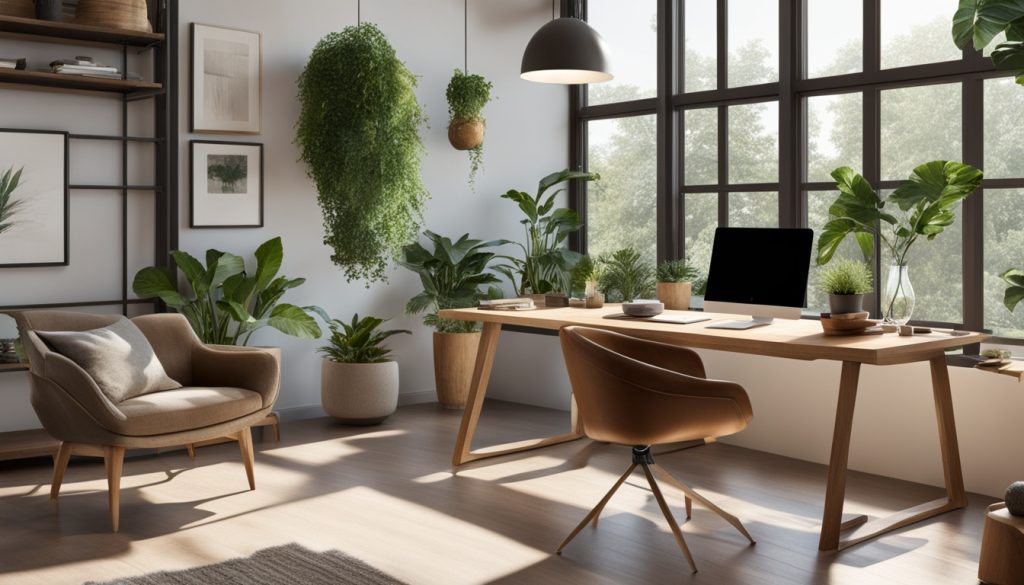
Creating a great home office is a process. Try out different things to see what works best for you. This will help improve your wellness and productivity.
Maintaining Good Posture and Habits in Your Home Office
Working from home means you need to make a conscious effort to keep good posture and healthy habits. It’s important to support your posture to avoid discomfort and prevent long-term health problems. Let’s look at some ways to stay well and avoid injuries at your desk.
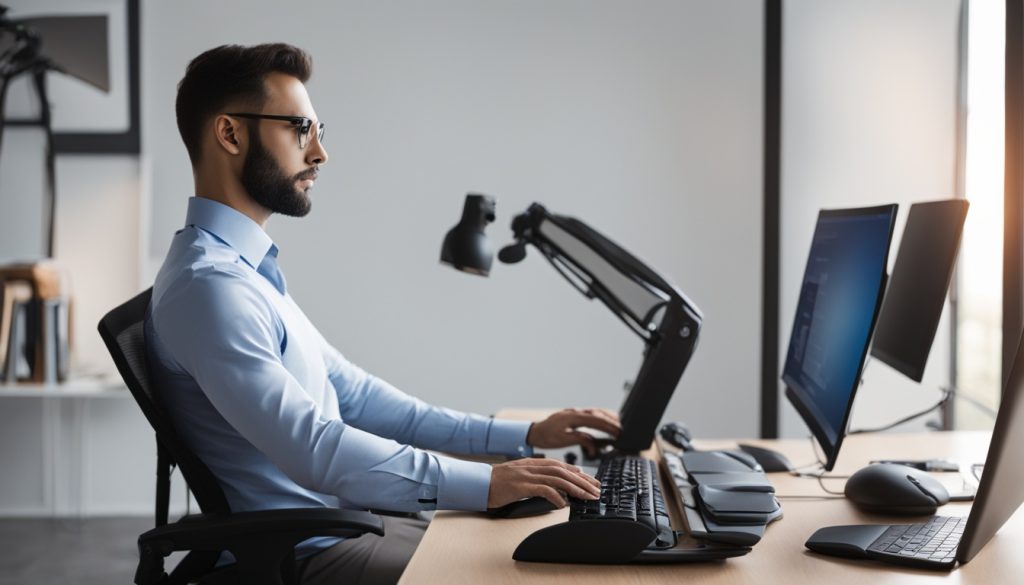
First, set up your workspace right. Make sure your chair is at the right height so your feet touch the floor and your knees are straight. Your computer screen should be at eye level to prevent neck pain. These simple steps can make a big difference in how you feel all day.
It’s also key to move regularly. Set reminders to stand up and stretch every hour. Here are some easy exercises to try:
- Shoulder rolls
- Neck stretches
- Wrist rotations
- Ankle circles
Don’t forget to take short breaks to prevent injuries. Try walking, deep breathing, or desk yoga. These activities refresh your mind and body, lowering the chance of getting hurt from doing the same thing over and over.
“Your body is designed for movement. Regular activity not only improves physical health but also boosts productivity and mental well-being.”
Good posture is more than just sitting up straight. It’s about making your workspace support your natural movements. By focusing on posture support and wellness, you’ll make your home office healthier and more comfortable.
Conclusion
Creating an ergonomic home office is key for your health and productivity. By following the tips shared, you can make a workspace that supports your body and helps you work better. Every detail, from the chair to the lighting, affects your comfort and health.
Setting up a remote work area doesn’t have to be hard. Begin with simple changes, like adjusting your chair or moving your monitor. These small changes can greatly improve how you feel after work. Remember, making your home office ergonomic means creating a space that suits you.
As you use these ergonomic tips, pay attention to how your body feels. Listen to what it tells you and adjust as needed. Your home office should be where you can work comfortably and efficiently for long periods. By focusing on ergonomics, you’re looking after your health and career.

